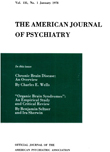A CLINICAL AND SOCIO-CULTURAL STUDY OF 200 PSYCHIATRIC PATIENTS STARTED ON CHLORPROMAZINE 10 ½ YEARS AGO
Abstract
Clinical. 1. Two hundred psychiatric patients were treated with chlorpromazine from the start of an initial trial of the drug in 1953 and followed until they had a remission, discontinued, or continued in maintenance therapy. Efficacy in the series attained the level generally reported by other investigators, countering the findings of those reporting only minimal response. Half of the schizophrenics had a lasting remission, including those who discontinued and 35 who still take the drug. More than % of the schizophrenics were markedly improved, in an average of 5 years of treatment. Chlorpromazine clearly had an anti-psychotic activity, consisting of anti-delusional and anti-hallucinatory activity, in addition to its anti-agitation activity. Of the psychoneurotics 2/3 were significantly improved in an average of 2½ years' treatment.
2. Chlorpromazine, although less effective in psychoneurotic patients than in psychotics, nevertheless had anti-phobic activity and anti-obsessional-compulsive activity, in addition to its anti-anxiety activity. These actions the so-called "minor tranquilizers" do not possess, and for this reason also, a phenothiazine is indicated in the psychoneuroses, especially when obsessive-compulsive and phobic symptoms are present.
3. In chronic disturbances treatment must be evaluated on its long-term results. Chlorpromazine admirably met the basic criterion of immediate therapeutic benefits and maintenance of results over an indefinite period of time.
4. Nearly 3/4 of the series had recurrence of symptoms after discontinuing medication, but in a large majority resumption produced remission, and continuance maintained improvement. Strong recommendation for maintenance therapy will often prevent the great disruption in the life of the patient who discontinues treatment.
5. Relapses following discontinuance of medication occurred 3 days to 6 months afterwards, with most occurring in 2 to 6 weeks. The longer the duration of treatment, the longer the time before a relapse.
6. Side effects of physiologic sensitivity were frequent but confined to the initial weeks of treatment; tolerance developed early to all except weight gain. Toxicallergic reactions, 3 cases of jaundice and one of dermatitis, were reversed on suspension of the drug. Negative perceptual reactions occurred more among the psychoneurotics than the schizophrenics and more among patients on the lower social level than those on upper levels. This slight incidence of side effects should allay the fears of those who still hesitate to use chlorpromazine for this reason.
Socio-cultural. 1. The higher the social level the better the clinical response, both short-term and long-term. The higher-level patients had an ever-increasing number of remissions and those well maintained, while the lower-level patients, more recurrences.
2. The critical point of therapeutic difference between the levels appeared to lie between the salesmen and the factory workers. Patients above this point were similar to one another in clinical response, and patients below it were likewise similar, with response tending to be better farther up the scale and worse farther down.
3. The chief socio-cultural differences which affect clinical response seemed to be contrasting attitudes toward illness and drug treatment. Acceptance and cooperation characterize higher-level attitudes, while resistance and fear characterize lower level attitudes.
4. The attitude that seemed to have most effect on therapeutic outcome was that toward long-term drug use.
5. There were more, earlier, and longer remissions in higher-level patients, apparently due to more adequate dosage.
6. Maintenance dosages averaged about twice as much in the private patients as in the factory workers; in the salesmen dosages averaged somewhat less than in the private patients.
7. Socio-cultural values affected clinical behavior to such an extent that when a patient responded in a way clearly atypical of his class, it was found he had interests, habits and values of a class higher or lower and he was working and living below or above his potential level because of economic circumstances and psychological difficulties. Hence, the patient's management of his drug regimen may be an indicator of social mobility, upward or downward.
8. Socio-cultural influences on clinical response are more marked in the psychoneurotic than in the schizophrenic; such influences decline with greater degree of regression, and are all but non-existent in the regressed schizophrenic.
Access content
To read the fulltext, please use one of the options below to sign in or purchase access.- Personal login
- Institutional Login
- Sign in via OpenAthens
- Register for access
-
Please login/register if you wish to pair your device and check access availability.
Not a subscriber?
PsychiatryOnline subscription options offer access to the DSM-5 library, books, journals, CME, and patient resources. This all-in-one virtual library provides psychiatrists and mental health professionals with key resources for diagnosis, treatment, research, and professional development.
Need more help? PsychiatryOnline Customer Service may be reached by emailing [email protected] or by calling 800-368-5777 (in the U.S.) or 703-907-7322 (outside the U.S.).



